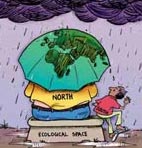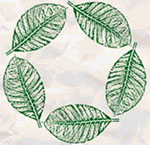 CSE
counters the move by industrialised countries to split the stand of developing countries
on emissions reduction. When the small island nation states (AOSIS) asked the rich
countries to reduce emissions by 20 per cent by 2005, the developed world led by Germany,
countered by making the AOSIS proposal conditional to large developing countries also
reducing their emissions by a similar level. CSE took strong exception to this unfair
proposal by pushing more than 50 Northern NGOs to lobby against this with their government
negotiators. CSE lobbied with the Climate Action Network, made presentations and organised
press conferences in Delhi, Berlin and New York City. The combined pressure of
environmentalists and the media forced the German negotiators to withdraw their
controversial proposal. This year also saw CSE foraying into its maiden video venture, CSE
produced a series of three videos on sustainable village ecology called The Wealth of the Nation. The same year, CSE also
produced Harvest of Rain which deals with
traditional water harvesting techniques. Similarly, the video The
Village Republic dealt with decentralised governance as an answer to rural
India's threatened ecological existence.
CSE
counters the move by industrialised countries to split the stand of developing countries
on emissions reduction. When the small island nation states (AOSIS) asked the rich
countries to reduce emissions by 20 per cent by 2005, the developed world led by Germany,
countered by making the AOSIS proposal conditional to large developing countries also
reducing their emissions by a similar level. CSE took strong exception to this unfair
proposal by pushing more than 50 Northern NGOs to lobby against this with their government
negotiators. CSE lobbied with the Climate Action Network, made presentations and organised
press conferences in Delhi, Berlin and New York City. The combined pressure of
environmentalists and the media forced the German negotiators to withdraw their
controversial proposal. This year also saw CSE foraying into its maiden video venture, CSE
produced a series of three videos on sustainable village ecology called The Wealth of the Nation. The same year, CSE also
produced Harvest of Rain which deals with
traditional water harvesting techniques. Similarly, the video The
Village Republic dealt with decentralised governance as an answer to rural
India's threatened ecological existence.
 CSE
published Slow Murder: The Deadly Story of
Vehicular Pollution in India, the first systematic study that presented a comprehensive
picture of the causes of vehicular pollution in Indian cities - ranging from poor engine
technology and fuel quality to traffic planning and engine maintenance. The book sparked a
nationwide discussion on the growing menace of urban air pollution. Noticed by the Supreme
Court, the government of Delhi had to file an action plan on how to reduce the city's air
pollution.
CSE
published Slow Murder: The Deadly Story of
Vehicular Pollution in India, the first systematic study that presented a comprehensive
picture of the causes of vehicular pollution in Indian cities - ranging from poor engine
technology and fuel quality to traffic planning and engine maintenance. The book sparked a
nationwide discussion on the growing menace of urban air pollution. Noticed by the Supreme
Court, the government of Delhi had to file an action plan on how to reduce the city's air
pollution.
After completing a
seven-year exercise, which documented India's traditional knowledge in rainwater
harvesting technology management, CSE published the seminal book, Dying Wisdom: The Rise, Fall and Potential of Traditional
Water Harvesting Systems as
part of its Citizens' Fourth Report on the State of India's Environment (SOE-4). This
influential book pointed out that pre-colonial India's rural prosperity and urban
development was built on a variety of rainwater harvesting techniques. Instead of
depending exclusively on the state for water supply, a paradigm that is not even two
hundred years old, water should once again become everybody's business. The Central
Government, in addition to several Indian states including Madhya Pradesh, Gujarat and
Andhra Pradesh have since launched major rainwater harvesting initiatives to combat
drought and widespread land degradation. CSE's publication, Homicide
by Pesticides presented a study on pollution in
the Yamuna river basin and showed how pesticides used on farmlands in the upper reaches of
the river were seeping into the drinking water of towns and cities downstream. The same
year, CSE shocked India's citizens with its data on the death count resulting from urban
air pollution. In Delhi, one of the worst cities in India, one person died every hour from
air pollution in 1995. Between 1991-92 and 1995, deaths doubled in the city, from 5,726 to
10,647.
pre-colonial India's rural prosperity and urban
development was built on a variety of rainwater harvesting techniques. Instead of
depending exclusively on the state for water supply, a paradigm that is not even two
hundred years old, water should once again become everybody's business. The Central
Government, in addition to several Indian states including Madhya Pradesh, Gujarat and
Andhra Pradesh have since launched major rainwater harvesting initiatives to combat
drought and widespread land degradation. CSE's publication, Homicide
by Pesticides presented a study on pollution in
the Yamuna river basin and showed how pesticides used on farmlands in the upper reaches of
the river were seeping into the drinking water of towns and cities downstream. The same
year, CSE shocked India's citizens with its data on the death count resulting from urban
air pollution. In Delhi, one of the worst cities in India, one person died every hour from
air pollution in 1995. Between 1991-92 and 1995, deaths doubled in the city, from 5,726 to
10,647.
CSE revealed data to show that the growth in pollution is
far outstripping the growth in the economy posing serious questions about the state of the
environment in the decades to come unless concerted efforts were made to control
pollution. Between 1975 and 1995, India's GDP increased 2.6 times but the industrial
pollution load went up 3.5 times and the vehicular pollution load went up 7.5 times. In
July, perhaps the first of its kind in the country, CSE organised a national-level
conference on Health and Environment which drew more than 40 renowned health and medical
experts from across the country. In October, CSE organised a National Conference of Water
Harvesting in New Delhi which drew water harvesters from all across the country.
 Five-Leaf Award launched. This
first-ever NGO rating of industry was instituted as part of CSE's Green Rating Project.
This pioneering effort seeks to bring about greater transparency in industrial performance
in environmental management, by rating companies in various sectors that helps in
identifying and distinguish the good ones from the environmental black sheep. The first
study, which involved numerous readers of Down to Earth as
voluntary inspectors across the country, examined the highly polluting pulp and paper
sector. Detailed profiles of 28 Pulp and Paper Mills and a Technical Issues Report were
made available for public dissemination by CSE. The project has developed an approach that
can be used by any NGO in any developing country to monitor the environmental performance
of industrial firms even if its environmental governance is very poor. CSE sets up a
Five-Leaf Award launched. This
first-ever NGO rating of industry was instituted as part of CSE's Green Rating Project.
This pioneering effort seeks to bring about greater transparency in industrial performance
in environmental management, by rating companies in various sectors that helps in
identifying and distinguish the good ones from the environmental black sheep. The first
study, which involved numerous readers of Down to Earth as
voluntary inspectors across the country, examined the highly polluting pulp and paper
sector. Detailed profiles of 28 Pulp and Paper Mills and a Technical Issues Report were
made available for public dissemination by CSE. The project has developed an approach that
can be used by any NGO in any developing country to monitor the environmental performance
of industrial firms even if its environmental governance is very poor. CSE sets up a  National
Water Harvesters Network to share information and resources with water harvesters
across the country. As part of this effort, CSE starts publishing the seminal Catch
Water newsletter on water harvesting to support CSE's People's Water Management
campaign. CSE published the first report on Global Environmental Negotiations (GEN-1)
titled , Green Politics which was first
released during the fifth Conference of Parties to the Climate Convention (CoP-5) held in
Bonn, Germany. Special book release events were held around the world over the next year.
National
Water Harvesters Network to share information and resources with water harvesters
across the country. As part of this effort, CSE starts publishing the seminal Catch
Water newsletter on water harvesting to support CSE's People's Water Management
campaign. CSE published the first report on Global Environmental Negotiations (GEN-1)
titled , Green Politics which was first
released during the fifth Conference of Parties to the Climate Convention (CoP-5) held in
Bonn, Germany. Special book release events were held around the world over the next year.
 CSE
counters the move by industrialised countries to split the stand of developing countries
on emissions reduction. When the small island nation states (AOSIS) asked the rich
countries to reduce emissions by 20 per cent by 2005, the developed world led by Germany,
countered by making the AOSIS proposal conditional to large developing countries also
reducing their emissions by a similar level. CSE took strong exception to this unfair
proposal by pushing more than 50 Northern NGOs to lobby against this with their government
negotiators. CSE lobbied with the Climate Action Network, made presentations and organised
press conferences in Delhi, Berlin and New York City. The combined pressure of
environmentalists and the media forced the German negotiators to withdraw their
controversial proposal. This year also saw CSE foraying into its maiden video venture, CSE
produced a series of three videos on sustainable village ecology called The Wealth of the Nation. The same year, CSE also
produced Harvest of Rain which deals with
traditional water harvesting techniques. Similarly, the video The
Village Republic dealt with decentralised governance as an answer to rural
India's threatened ecological existence.
CSE
counters the move by industrialised countries to split the stand of developing countries
on emissions reduction. When the small island nation states (AOSIS) asked the rich
countries to reduce emissions by 20 per cent by 2005, the developed world led by Germany,
countered by making the AOSIS proposal conditional to large developing countries also
reducing their emissions by a similar level. CSE took strong exception to this unfair
proposal by pushing more than 50 Northern NGOs to lobby against this with their government
negotiators. CSE lobbied with the Climate Action Network, made presentations and organised
press conferences in Delhi, Berlin and New York City. The combined pressure of
environmentalists and the media forced the German negotiators to withdraw their
controversial proposal. This year also saw CSE foraying into its maiden video venture, CSE
produced a series of three videos on sustainable village ecology called The Wealth of the Nation. The same year, CSE also
produced Harvest of Rain which deals with
traditional water harvesting techniques. Similarly, the video The
Village Republic dealt with decentralised governance as an answer to rural
India's threatened ecological existence.